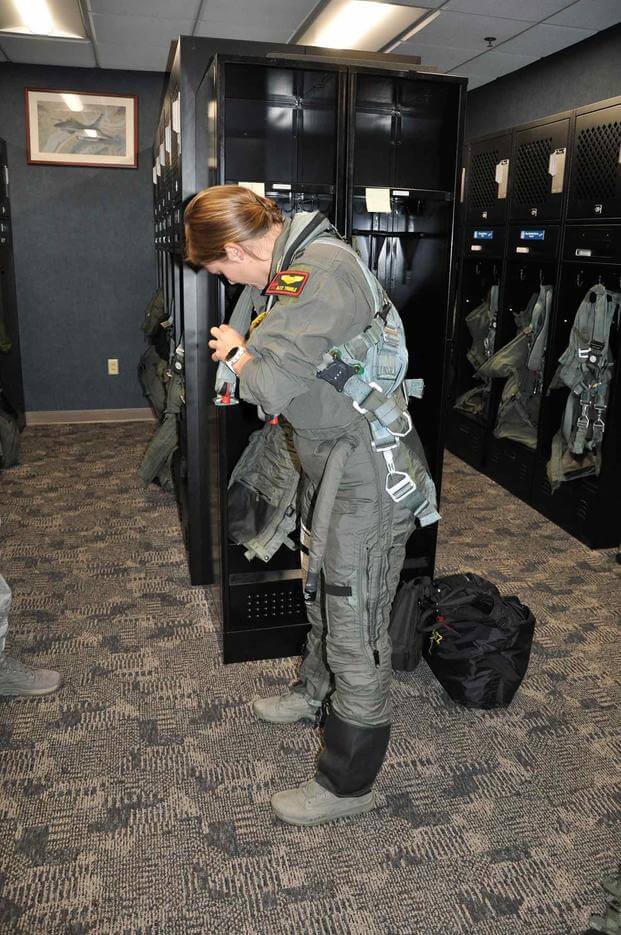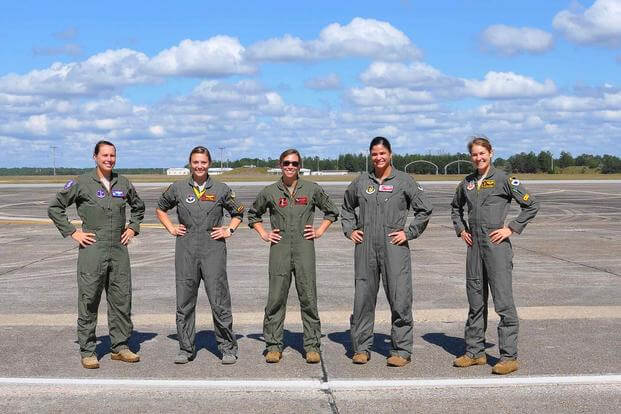The U.S. Air Force just tested a modified "G-suit" designed with women in mind.
Last week, five female fighter pilots donned an updated version of the Advanced Technology Anti-Gravity Suit (ATAGS), specialized compression gear worn over a flight suit to help pump blood through the body when under the stresses of gravity during high-speed flight.
Read Next: Navy OKs New Uniform Rank Tabs After Sailors Say Camo Caused 'Uncomfortable Gaze'
For 20 years, ATAGS had been designed for men. The redesigned suit has better adjustment straps to accommodate a variety of body types and an optional, form-fitted waist compression, according to a service release.
"In the past, some pilots with a shorter torso have had issues with ATAGS that were too large riding up and causing bruising on the rib cages, while pilots who are hard-to-fit may have had one size that fits through the legs, but need a smaller size in the waist," said Charles Cruze, an engineer with the Air Force Life Cycle Management Center's Human Systems Division, in the release. "Now, the waist can now be darted up to 3.75 inches, allowing for a more custom and accurate fit, preventing both of those issues."
The service manufactured wider lacing panels "in the waist, thigh and calf, which allows the suit to be easily adjusted for different body proportions, and the option for a 'darted' or tailored, custom waist that does not reduce performance of the waist bladder that inflates during high-G maneuvers," the release states.

While the new lacing panels will be standard for all, the tailored waist portion is elective for the few men or women who may need it, explained 1st Lt. Savanah Bray, spokeswoman for the 53rd Wing at Eglin Air Force Base, Florida. The ATAGS tests were conducted by the 85th Test and Evaluation Squadron, which falls under the 53rd, in conjunction with the 46th Test Squadron and 96th Test Wing.
"The waist option is not going to be mass-produced in all [suits] because it's custom," Bray said Tuesday.
The service is currently looking at how airmen can request custom sizing "[since] the process has not been formalized," Bray told Military.com. She stressed that the waist option "is applicable to anyone who needs it."
The goal is to get the enhanced G-suits to fighter pilots and aircrew who need them within 12 to 24 months, the release states.
During the tests, five fighter pilots and one aircrew member wore the modified G-suits while flying F-16 Fighting Falcons, conducting low- and high-G basic fighter maneuvers during 20 different sorties, according to the release.
For safety reasons, two-seater F-16D model jets were used -- one pilot wore the modified ATAGS while the co-pilot wore the standard suit as backup in the event of a malfunction with the refitted equipment. Doing so also allowed the pilots to compare the suits' performance, the service said.
"Pilots were asked to evaluate based on not only the ATAGS during high-G maneuvers, but also during regular activities like sitting, standing, walking and climbing into and out of the aircraft," said Sharon Rogers, lead test engineer with the 46th Test Squadron.
One pilot who tested the new suit said she saw a definite improvement.
"As more women strap into fast jets to get the mission done, I think the Air Force is heading in the right direction," Capt. Brittany Trimble, an F-16 instructor pilot who took part in the test, said in the release.
"I definitely noticed improvement with the new updates and the darted waist in particular," she said. "I honestly didn't expect to notice much of a difference because I'd never noticed significant issues with the ATAGS sizes before, but I was pleasantly surprised that these upgrades increased the ATAGS functionality significantly under G."
The latest news comes as the service has made upgrades to a variety of items as it redesigns gear and flight suits used by female pilots after many years of ill-fitting equipment.
For example, officials announced earlier this month that the Air Force will finally begin fielding body armor specifically designed for female airmen in Security Forces units.
In 2019, the service launched a project within the Air Force Life Cycle Management Center focused on gathering female perspectives to deliver better uniforms, including maternity uniforms and flight suits. It was prompted by then-Air Force Chief of Staff Gen. David Goldfein's mission to redesign female uniforms to improve comfort and ease of wear. The effort has been supported by the Department of the Air Force's Barrier Analysis Working Group within the Women's Initiative Team, which has been instrumental in encouraging change for outdated or restrictive policies.
"These don't seem like big issues, but everything counts in the air, and having gear that fits and works as intended should be the standard," Trimble said in the ATAGS release. "I'm excited the Air Force is working to identify and fix these issues, especially in innovative ways like [providing aircrew flight equipment] new modification options."
-- Oriana Pawlyk can be reached at oriana.pawlyk@military.com. Follow her on Twitter at @oriana0214.












